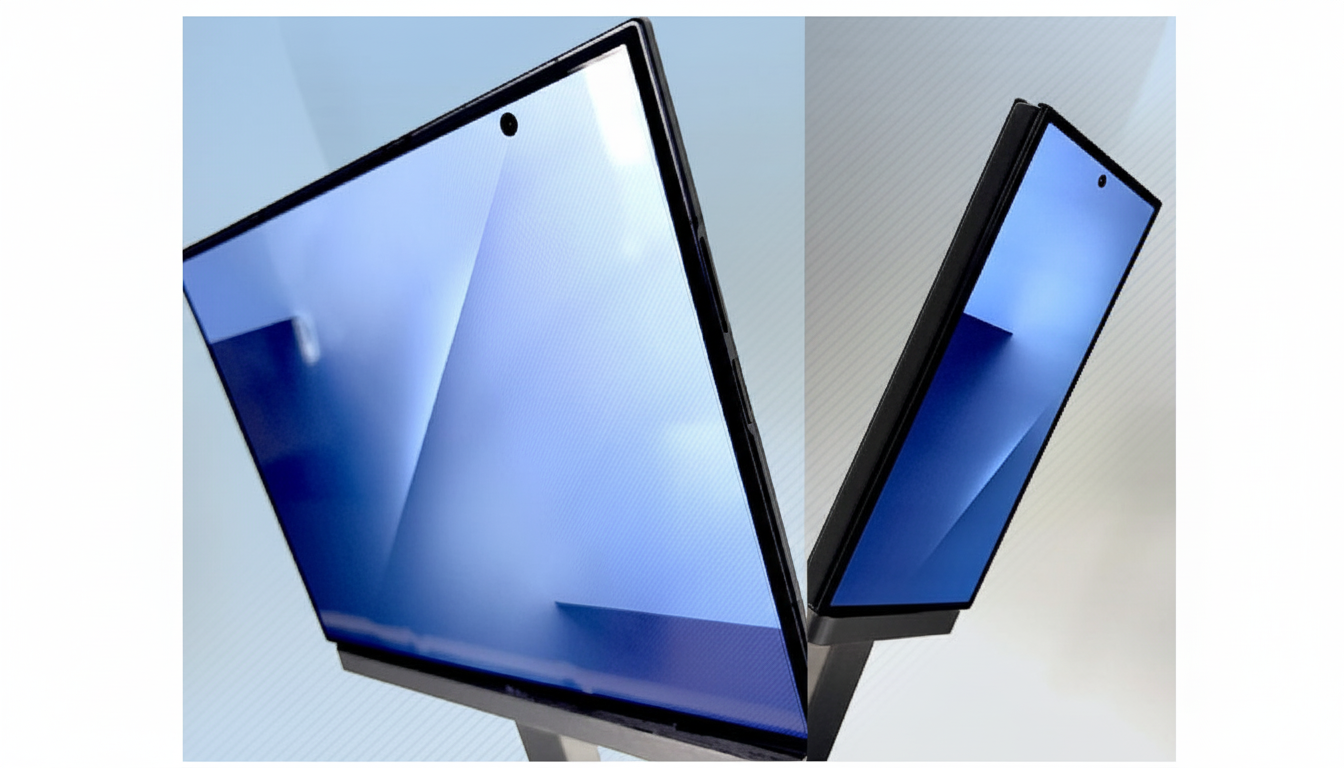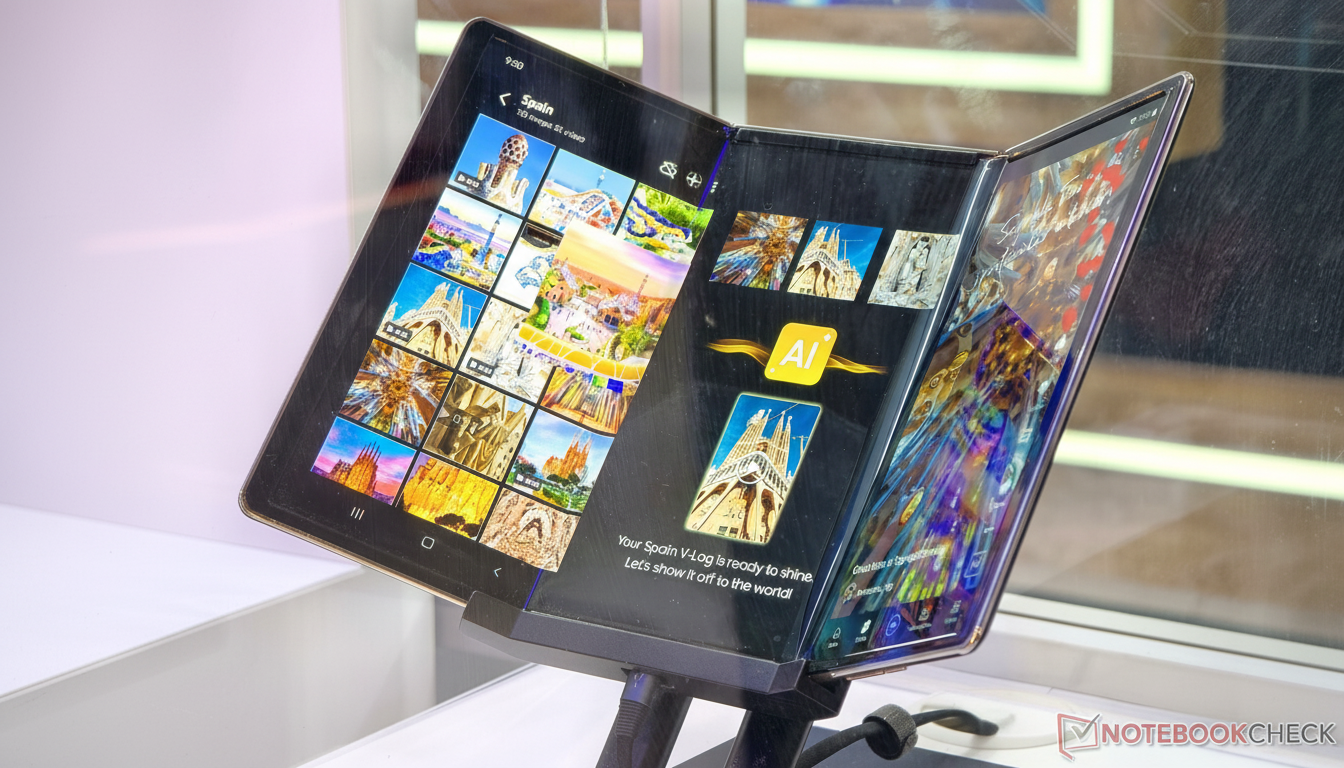Samsung’s long-rumored tri-foldable has finally arrived in the flesh, as new images provide our clearest look at what is likely to be named the Galaxy Z TriFold. Now, according to leaks from trusted tipster Ice Universe and as reported by Korean broadcasters, the proof might be in images showing a dual-hinge device on show around the APEC Summit in South Korea — indicating that Samsung has started the shift from prototype to product.
What the leaked images reveal about the tri-fold design
The glimpsed screens show a single OLED panel that folds in twice, going from a candy bar-like exterior to a tablet-like display when unfolded. A centered punch-hole camera is perched at the top of the internal screen, and bezels appear a little more pronounced than they do on recent single-fold Samsung devices — which is to be expected given the extra hinge intricacies.
- What the leaked images reveal about the tri-fold design
- Why a G-shaped hinge matters for Samsung’s tri-fold
- It’s Software that Will Make or Break It
- How it compares with rival tri-fold and foldable phones
- Availability and price outlook for Samsung’s tri-fold
- What to watch next as Samsung’s tri-fold nears launch

In the rear, the leftmost section sports what looks like a familiar island with a triple-camera setup inspired by the design language of the Galaxy Z Fold line. The middle portion will reportedly house the cover display, which means it’ll be usable with the display closed at a glance. The overall design is consistent with Samsung Display’s “Flex G” concept shown at industry expos, which features both hinges folding inward to cover the main screen.
Why a G-shaped hinge matters for Samsung’s tri-fold
While some rivals use an S-shaped design — such that there is a hinge that folds outward — Samsung’s approach, the G-shaped design, tucks both folds inside. The advantages are obvious: the flexible panel is less vulnerable to scratches and pocket grit, and cases will be easier to make since there’s no external plastic layer to protect. Trade-offs include thickness and engineering complexity across two hinge modules, with their respective tolerance stack.
Durability will be a key issue. Samsung’s most recent foldables have been rated by the company as capable of about 200,000 folds. A tri-fold inherently brings in more stress points, further rolling radii to contain, and increased cumulative strain on the ultra-thin glass and adhesive stack. Anticipate tightening of hinge cams, spine reinforcement, and layer adhesion to mitigate crease depth while enhancing long-term durability.
It’s Software that Will Make or Break It
The hardware unlocks the form factor; it’s up to One UI to make the thing sing. Samsung already offers multi-window on the Fold series, allowing you to dock up to three apps with resizable panes and floating windows. A tri-fold could take that even further — tri-pane email, simultaneous note-taking next to a video call, or a photo timeline spread across two panels with tools docked on the third.
Pen-based input would also seem a natural fit with anything near a tablet-sized canvas, assuming — and it is far from assured — Samsung can maintain sufficient panel rigidity under scribe-layer pressure. Continuity — the handshake between the cover display and the full, open layout — is more complicated with two hinges too. Keep an eye out for smarter window persistence, per-panel task snapping, and DeX-like productivity behaviors that spring to life contextually when you open each panel.

How it compares with rival tri-fold and foldable phones
It has been reported that Huawei’s new large-format foldable uses a mixed in–out hinge (S-curve) which can provide a thinner closed footprint, but that design results in half the main screen facing outwards. Samsung’s in-orientation-only approach focuses on protection, and may help overall case availability and longer-term durability as well. Other brands have displayed tri-fold prototypes over the years, but none has arrived at global scale.
Market context matters here. Counterpoint Research analysts have observed a not insignificant double-digit rise in foldables since 2020, with Samsung also leading the worldwide charge despite mounting competition in China. A well-made tri-fold would also be the ticket for Samsung to once again stake its claim at the high end of the category, distancing itself from book-style and clamshell competitors.
Availability and price outlook for Samsung’s tri-fold
Rumors indicate that the Galaxy Z TriFold will first launch in certain Asian markets — South Korea, China, Singapore, and Taiwan come to mind — with general availability still up in the air. A limited release would make sense, given the supply-side demands — tri-fold panels depend on a higher yield of flexible OLED production; two strong hinge assemblies along with stricter QA could all lead to cost and carrier certification complexity.
Pricing is a big question mark, but assume you’d pay a premium over today’s large foldables due to the extra materials and engineering. Samsung may position the product as a halo device for early adopters and professionals who want to get as much screen real estate as they can without owning another tablet.
What to watch next as Samsung’s tri-fold nears launch
The device has allegedly been spotted for display at the APEC Summit in South Korea, a fresh signal suggesting that Samsung is prepared to let it see the light of day beyond R&D labs. Related: read about hinge life testing, reducing the crease, and software multitasking, plus possible S Pen support if an official launch does occur. The actual battery numbers and weight will be telling, too — two hinges and three panels don’t leave a lot of room for inefficiency.
The bottom line, for the moment: Samsung’s tri-fold is no longer a concept. With these first real images out, the race to shape the next era of foldables has entered a new phase — and Samsung looks set to raise the bar.

